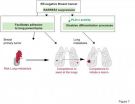(Press-News.org) Climate changeButterflies and dragonflies with a lighter shade of colour do better in warmer areas of Europe. This gives them a competitive advantage over the darker insects in the face of climate change. Changes in Europe's insect assemblages due to warming can already be seen for dragonflies, shows a study recently published in Nature Communications.
"When studying biodiversity, we lack general rules about why certain species occur where they do. With this research we've been able to show that butterfly and dragonfly species across Europe are distributed according to their ability to regulate heat through their colour variation," explains leading author Dirk Zeuss from Philipps-University Marburg in Germany.
Together with colleagues from the University of Copenhagen and Imperial College London, the scientists showed a clear pattern of light-coloured insects dominating the warmer south of Europe and darker insects dominating the cooler north. Furthermore, they showed that for dragonflies, the insect assemblage in Europe has on average gotten lighter during the last decades. A response the authors attribute to climate change.
Colour is of overriding importance for heat regulation
Insects, like lizards and snakes absorb energy from the sun to become mobile. The darker the colour they have, the more sunlight they can exploit. Therefore it makes sense to see darker insects in cooler climates. However, the researchers were surprised to find such a distinguished colour pattern between the northern and southern species, since the surface colours also serve many other purposes such as camouflage. This underlines the importance of heat regulation in insects.
"For two of the major groups of insects, we have now demonstrated a direct link between climate, insect colour and habitat preference," says Carsten Rahbek, Director of the Center for Macroecology, Evolution and Climate at the University of Copenhagen and professor at Imperial College London.
He is co-author of the study that was carried out using digital image analysis of 473 different species of butterflies and dragonflies together with information on their habitat.
The study also indicates that darker insects will shift their distribution and possibly retreat from certain areas or on a smaller scale, find more shady conditions. Such responses have implications for conservation strategies.
Closer to an explanation
The past two decades scientists have observed that several Mediterranean dragonfly species, such as the Southern Migrant Hawker (Aeshna affinis), the Scarlet Darter (Crocothemis erythraea) and the Dainty Damselfly (Coenagrion scitulum), have expanded their northern range and immigrated e.g. to Germany.
Similarly, Mediterranean butterfly species like the Southern Small White (Pieris mannii) have dispersed to Germany during the last ten years and are still continuing their northward shift.
"Until now we could only watch the massive changes in the insect fauna during the last 20 years. Now we have an idea of what could be a strong cause of the changes," says Stefan Brunzel, co-author from Philipps-University Marburg.
INFORMATION:
The study is published in Nature Communications, DOI: 10.1038/NCOMMS4874.
CONTACT
Dirk Zeuss
Mobile: +49 6421 28 23381
E-mail: dirk.zeuss@biologie.uni-marburg.de
Stefan Brunzel
Phone: +49 6424 943130
E-mail: brunzel@staff.uni-marburg.de
Carsten Rahbek
Mobile: +45 38 79 48 60
E-mail: crahbek@snm.ku.dk
Climate warming favors light-colored insects in Europe
2014-05-27
ELSE PRESS RELEASES FROM THIS DATE:
Why are girl babies winning in the battle for survival?
2014-05-27
Sexual inequality between boys and girls starts as early as in the mother's womb – but how and why this occurs could be a key to preventing higher rates of preterm birth, stillbirth and neonatal death among boys.
A team from the University of Adelaide's Robinson Research Institute has been studying the underlying genetic and developmental reasons why male babies generally have worse outcomes than females, with significantly increased rates of pregnancy complications and poor health outcomes for males.
The results - published today in the journal Molecular Human Reproduction ...
Medical mechanics
2014-05-27
Removing a malignant tumor from the head of the pancreas is a risky and demanding operation. The surgeon must carefully navigate around the stomach, the gallbladder, the bile duct, lymph nodes, and several high-pressure blood vessels.
But an inexpensive device designed by Harvard engineering students and a surgeon at Beth Israel Deaconess Medical Center offers surgeons a confident grip throughout the delicate procedure. The gentle grasper, equipped with rubberized pressure sensors, has three slender fingers that can slip through a very small incision and tease cancerous ...
Just look, but don't touch: EMA terms of use for clinical study data are impracticable
2014-05-27
The European Medicines Agency (EMA) receives comprehensive clinical study data from drug manufacturers. These data form the basis for the decision on the approval of new drugs. To make this information available to researchers and decision-makers, EMA issued a draft policy in 2013 for the publication of clinical study data, in which extensive data transparency was planned.
Besides other interested parties, the German Institute for Quality and Efficiency in Health Care (IQWiG) was intensely involved in the subsequent consultations. The result of these consultations is ...
The future of sweet cherry in Australia
2014-05-27
AUSTRALIA -- Predicted variations in global climates have fruit producers trying to determine which crops are best suited to weathering future temperature changes. Extreme high-temperature events are expected to become more frequent, and predictive models suggest that the global mean surface air temperature will rise by as much as two degrees by the middle of the 21st century. Higher temperatures could have an impact on the duration of critical "winter chill" periods needed for successful fruit production, potentially altering growing strategies. According to the authors ...
Differences in phenolic makeup of indigenous rose species and modern cultivars
2014-05-27
LJUBLJANA, SLOVENIA – The leaves and petals of roses are valued for their medicinal and aesthetic uses around the world. A new study identified specific phenolic compounds found in the petals of indigenous rose species and compared them with the phenolic profiles of modern rose cultivars to determine differences in the makeup of roses traditionally used for medicinal purposes and those varieties cherished for aesthetic qualities. According to the results, distinct differences exist in the distribution of leaf phenolic compounds, especially between indigenous rose species ...
Researchers identify a new suppressor of breast metastasis to the lung
2014-05-27
A study published today in EMBO Molecular Medicine reveals that the loss of function of the gene RARRES3 in breast cancer cells promotes metastasis to the lung.
The research, headed by Roger Gomis, ICREA Professor at the Institute for Research in Biomedicine (IRB Barcelona), is the result of a collaboration between two IRB labs and Joan Massagué, at the Memorial Sloan Kettering Cancer Center in New York.
The scientists demonstrate that RARRES3 is suppressed in estrogen receptor-negative (ER-) breast cancer tumours, thus stimulating the later invasion of the cancer cells ...
The science of school lunch
2014-05-27
In terms of ambience, Charlotte Central's cafeteria is -- well, conjure up your own elementary school lunch experience. There's more than one reason to run to recess. But on a recent visit to observe a group of researchers from UVM's Johnson Lab, the lunch ladies were serving up something more likely to be found on a restaurant menu: risotto with mushrooms and peas. It's the result of a host of programs by schools around Vermont to offer more tempting choices -- with locally sourced ingredients when possible, including herbs and vegetables from the playground garden -- ...
New University of Colorado study illuminates how cancer-killing gene may actually work
2014-05-27
Scientists armed with a supercomputer and a vast trove of newly collected data on the body's most potent "tumor suppressor" gene have created the best map yet of how the gene works, an accomplishment that could lead to new techniques for fighting cancers, which are adept at disabling the gene in order to thrive.
Scientists from the University of Colorado Cancer Center and the University of Colorado Boulder used a new technology to tease out how the p53 gene—which is responsible for recognizing damaged DNA in cells and then marking them for death—is actually able to suppress ...
Why retailers need to pay attention to the smell of their stores
2014-05-27
This news release is available in French. Montreal, May 27, 2014 — Retail stores overflowing with merchandise can make consumers feel claustrophobic rather than ready to spend. But the recent move towards open, minimally stocked spaces can leave them feeling just as anxious.
The solution to this shopping conundrum may be smell, as new research from Concordia University shows.
In a study recently published in the American Journal of Business, researchers from the university's John Molson School of Business (JMSB) suggest that, when diffused in retail environments, ...
Imaging scientists develop a better tool for tracking MS
2014-05-27
Imaging scientists at Western University's Robarts Research Institute (London, Canada) have developed a better way to track the progression of Multiple Sclerosis (MS) from its earliest stages. Led by Ravi Menon, PhD, the researchers used what's called "Quantitative Susceptibility (QS) Magnetic Resonance Imaging (MRI)," to measure damage in specific areas of the brain which the study showed to be common to all patients. The findings are published in advance online, in Radiology.
"In MS research, there is something we call a clinical-radiological paradox. When ...



